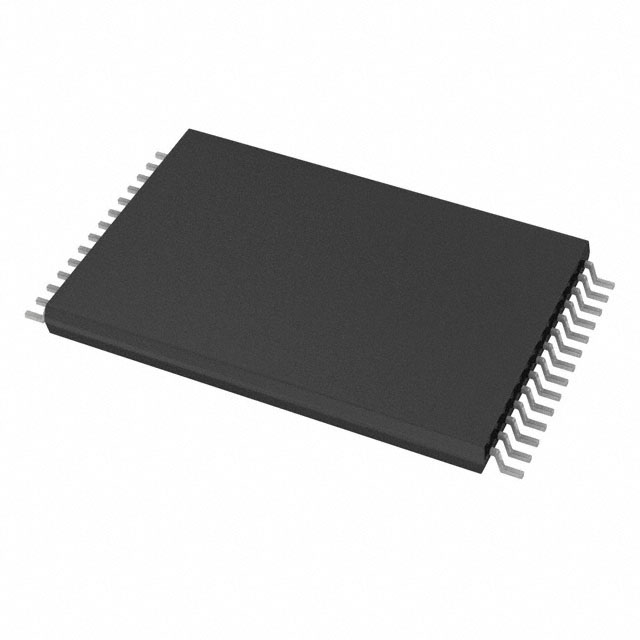Lihat spesifikasi untuk detail produk.

AT28C256E-15TU
Product Overview
Category
AT28C256E-15TU belongs to the category of electrically erasable programmable read-only memory (EEPROM) chips.
Use
This product is commonly used in electronic devices for storing and retrieving data. It allows for non-volatile storage, meaning that the stored information remains even when power is removed.
Characteristics
- Electrically erasable: The AT28C256E-15TU can be erased and reprogrammed electronically, making it convenient for updating or modifying stored data.
- High storage capacity: With a capacity of 256 kilobits (32 kilobytes), this EEPROM chip provides ample space for data storage.
- Fast access time: The AT28C256E-15TU has a fast access time of 150 nanoseconds, allowing for quick retrieval of stored information.
- Low power consumption: This chip operates on low power, making it suitable for battery-powered devices.
- Durable: The AT28C256E-15TU is designed to withstand multiple erase and write cycles, ensuring long-term reliability.
Package and Quantity
The AT28C256E-15TU is available in a surface-mount package (TSSOP-28). Each package contains one chip.
Specifications
- Memory capacity: 256 kilobits (32 kilobytes)
- Access time: 150 nanoseconds
- Supply voltage: 2.7V to 5.5V
- Operating temperature range: -40°C to +85°C
- Data retention: 10 years
- Endurance: 100,000 erase/write cycles
Pin Configuration
The AT28C256E-15TU has a total of 28 pins, which are assigned specific functions as follows:
- A0-A14: Address inputs
- CE: Chip enable
- OE: Output enable
- WE: Write enable
- VCC: Power supply voltage
- GND: Ground
The remaining pins are used for data input/output and other control signals.
Functional Features
- Byte-wise programmable: The AT28C256E-15TU allows individual bytes to be programmed or erased, providing flexibility in data storage.
- Automatic erase-before-write: This chip automatically erases the targeted memory locations before writing new data, simplifying the programming process.
- Hardware and software protection: The AT28C256E-15TU offers protection mechanisms to prevent accidental erasure or modification of stored data.
- High-speed operation: With a fast access time, this EEPROM chip enables efficient data retrieval and processing.
Advantages and Disadvantages
Advantages
- Electrically erasable and reprogrammable
- High storage capacity
- Fast access time
- Low power consumption
- Durable and reliable
Disadvantages
- Relatively higher cost compared to other non-volatile memory options
- Limited endurance compared to some newer memory technologies
Working Principles
The AT28C256E-15TU utilizes a floating-gate transistor structure to store and retrieve data. When programming, an electric charge is applied to the floating gate, altering its electrical characteristics and storing the desired data. Erasing is achieved by removing the charge from the floating gate. The chip's control signals determine the read, write, and erase operations.
Application Field Plans
The AT28C256E-15TU finds applications in various electronic devices that require non-volatile data storage, such as: - Microcontrollers - Embedded systems - Industrial automation equipment - Automotive electronics - Consumer electronics
Alternative Models
- AT28C256-15PU: This is a through-hole package variant of the AT28C256E-15TU, suitable for applications requiring a different mounting style.
- AT28C256R-15SC: This model offers similar specifications but comes in a smaller SOIC-28 package, ideal for space-constrained designs.
- AT28C256B-15JU: With extended temperature range (-40°C to +125°C), this model is suitable for harsh operating environments.
These alternative models provide options based on specific application requirements and design constraints.
In conclusion, the AT28C256E-15TU is a versatile EEPROM chip that offers high storage capacity, fast access time, and durability. Its electrically erasable and reprogrammable nature makes it an essential component in various electronic devices. While it may have some limitations, its advantages outweigh the disadvantages, making it a reliable choice for non-volatile data storage applications.
Sebutkan 10 pertanyaan dan jawaban umum terkait penerapan AT28C256E-15TU dalam solusi teknis
Sure! Here are 10 common questions and answers related to the application of AT28C256E-15TU in technical solutions:
Q: What is the AT28C256E-15TU? A: The AT28C256E-15TU is a 32K x 8 low-power CMOS EEPROM (Electrically Erasable Programmable Read-Only Memory) chip.
Q: What is the operating voltage range for the AT28C256E-15TU? A: The AT28C256E-15TU operates within a voltage range of 2.7V to 5.5V.
Q: What is the maximum clock frequency supported by the AT28C256E-15TU? A: The AT28C256E-15TU supports a maximum clock frequency of 150 kHz.
Q: How much data can be stored in the AT28C256E-15TU? A: The AT28C256E-15TU has a storage capacity of 256 kilobits or 32 kilobytes.
Q: Can the AT28C256E-15TU be reprogrammed multiple times? A: Yes, the AT28C256E-15TU is electrically erasable and can be reprogrammed multiple times.
Q: What is the typical endurance of the AT28C256E-15TU? A: The AT28C256E-15TU has a typical endurance of 100,000 erase/write cycles.
Q: Does the AT28C256E-15TU require an external power supply? A: Yes, the AT28C256E-15TU requires an external power supply within the specified voltage range.
Q: Can the AT28C256E-15TU operate in harsh environments? A: The AT28C256E-15TU is designed to operate within a temperature range of -40°C to 85°C, making it suitable for many applications.
Q: What interface does the AT28C256E-15TU use for communication? A: The AT28C256E-15TU uses a standard parallel interface for communication with the microcontroller or other devices.
Q: Are there any special considerations for programming the AT28C256E-15TU? A: Yes, the AT28C256E-15TU requires specific voltage levels and timing during programming, which should be followed as per the datasheet guidelines.
Please note that these answers are general and may vary depending on the specific application and requirements. It's always recommended to refer to the datasheet and consult technical documentation for accurate information.

